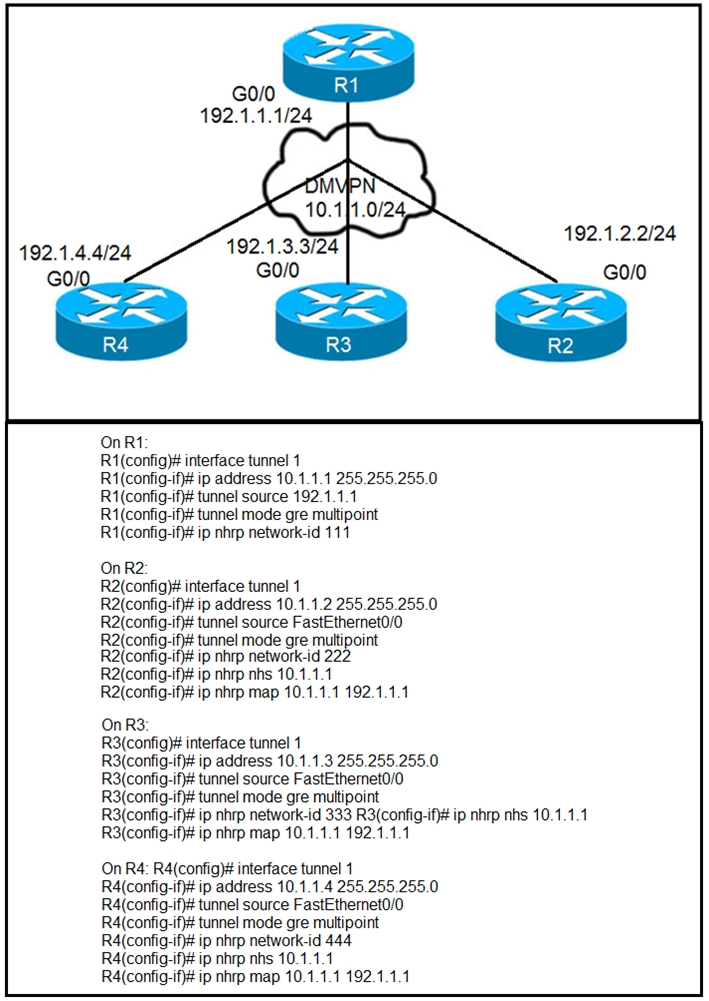
Refer to the exhibits. Phase-3 tunnels cannot be established between spoke-to-spoke in DMVPN.
Which two commands are missing? (Choose two.)

Refer to the exhibits. Phase-3 tunnels cannot be established between spoke-to-spoke in DMVPN.
Which two commands are missing? (Choose two.)
In Phase 3 DMVPN, the ip nhrp redirect command is necessary on the hub router to notify spoke routers of suboptimal traffic paths, which facilitates the spoke-to-spoke tunnel creation. Similarly, the ip nhrp shortcut command is needed on the spoke routers to allow them to use the shortcut paths indicated by the hub. These configurations allow spoke routers to dynamically establish direct tunnels between each other following the hub's redirection information, enabling efficient spoke-to-spoke communication.
Well, it's a really complicate question. For me, it's missing 3 commands. The "ip nghrp map multicast dynamic" and "ip nhrp redirect" in the hub. And the IP nhrp shortcut in the spokes. In a lab, the DMVPN Phase wouldn't work without theses 3 commands. BC seems correct, but without E it wouldn't work. It's complicated.
Hub(config)#interface tunnel 1 Hub(config-if)#ip nhrp redirect -> Hub notifies spoke routers of suboptimal traffic paths Spoke1(config)#interface tunnel 1 Spoke1(config-if)#ip nhrp shortcut -> Spokes send a resolution request for a shortcut path after receiving an NHRP redirect traffic indication message
B&C&D are all missing. But since the question is asking specifically about Phase 3 we assume that B&C are the write answers
also ip nhrp map multicast dynamic is missing. it allows NHRP to automatically add spoke routers to the multicast NHRP mappings.
OCG Pag 773 "The Phase 3 DMVPN configuration for the hub router adds the interface parameter command IP NHRP REDIRECT on the hub router. This command checks the flow of packets on the tunnel interface and sends a redirect message to the source spoke router when it detects packets hairpinning out of the DMVPN cloud. Hairpinning means that traffic is received and sent out an interface in the same cloud (identified by the NHRP network ID). For instance, hairpinning occurs when packets come in and go out the same tunnel interface. The Phase 3 DMVPN configuration for spoke routers uses the mGRE tunnel interface and uses the command IP NHRP SHORTCUT on the tunnel interface.
ip nhrp map command is also required on hub router to establish basic dmvpn connection, redirect and shortcut commands comes afterwards
The given answer is correct. HUB: redirect, Spoke: shortcut for phase 3 dmvpn
wrong answers E is correct since the Hub is missing command (ip NHRP map multicast dynamic) otherwise point-to point tunnel btw spokes wont form.
You don't need NHRP map on the Hub
For phase 3 dmvpn you do. You absolutely do. Got cisco press right in front of me. Nhrp provides a mapping service of the tunnel ip to the nbma ip. So if you want those juicy tunnel to nbma mappings that the hub keeps in its pockets to know when a spoke could use a more optimal path (ip nhrp redirect) it will forward the redirect packet to the destination spoke and it will resolve with the remote spoke. Ip nhrp shortcut is enabled by default, so D is not correct.
For phase 3 dmvpn you do. You absolutely do. Got cisco press right in front of me. Nhrp provides a mapping service of the tunnel ip to the nbma ip. So if you want those juicy tunnel to nbma mappings that the hub keeps in its pockets to know when a spoke could use a more optimal path (ip nhrp redirect) it will forward the redirect packet to the destination spoke and it will resolve with the remote spoke. Ip nhrp shortcut is enabled by default, so D is not correct.
Yea this is very misleading. For phase 3 spoke to spoke tunnels you have to have redirect on the hub and shortcut on the spokes. Yes the hub is missing the map command but this is specifically asking for phase 3 configurations.
For phase 3 dmvpn you do. You absolutely do. Got cisco press right in front of me. Nhrp provides a mapping service of the tunnel ip to the nbma ip. So if you want those juicy tunnel to nbma mappings that the hub keeps in its pockets to know when a spoke could use a more optimal path (ip nhrp redirect) it will forward the redirect packet to the destination spoke and it will resolve with the remote spoke. Ip nhrp shortcut is enabled by default, so D is not correct.
B&C are the best answers
I think question have a problem ip nhrp network-id different on int tun 1 cause dmvpn not up. if question is true. I choose B and C. shortcut and redirect is representative of dmvpn phase 3
The given answer is correct. Phase 3: Use ip nhrp redirect on hub routers & ip nhrp shortcuts on spoke routers. https://network-insight.net/2015/02/03/design-guide-dmvpn-phases/
Shortcut is needed on hub and spokes to initiate spoke-to-spoke tunnels. Redirect is an optimization that is needed for spoke-to-spoke communication only if you have summarized routes, if the spoke has the complete routing-table it is not needed. https://www.cisco.com/c/en/us/support/docs/security/dynamic-multipoint-vpn-dmvpn/211292-Configure-Phase-3-Hierarchical-DMVPN-wit.html#anc9 https://www.ciscozine.com/dmvpn-phase-3-guide/
B & C are correct